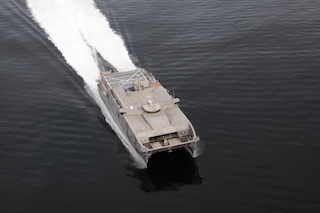Earlier this month, the Joint High Speed Vessel USNS Trenton (JHSV 5) completed acceptance trials in the Gulf of Mexico. The acceptance trials for the Austal USA-built JHSV are the last significant milestone before delivery of the ship.
The Trenton is the first of two JHSVs Austal is preparing for delivery to the Navy in 2015.
The trials involved intense comprehensive tests by the Navy while underway, which demonstrated the operation of the ship’s major systems and equipment.
“We’re very pleased with how well the Trenton performed,” Craig Perciavalle, Austal USA’s president said in a statement. “These trials proved the USNS Trenton is ready to start her naval service.”
Perciavalle added that the JHSV program has “matured very well.” He said the first four JHSVs have proven their value, participating in numerous major international naval exercises and serving several branches of the military including the Navy, Marines and Coast Guard.
Since delivery of USNS Spearhead (JHSV 1) in 2012, JHSVs have supported operations in Europe, Africa, and Southern and Pacific Command areas of responsibility. The Spearhead is currently deployed to the Gulf of Guinea for the international Exercise Obangame Express 2015.
The vessel is the fifth of 10 103-meter JHSVs that Austal has been contracted by the Navy to build at its Mobile, Ala., shipyard. The Navy selected Austal as the prime contractor for this $1.6 billion block buy contract in 2008. Austal teamed with General Dynamics Mission Systems to be the ship systems integrator, responsible for the design, integration and testing of the navigation, communications, and aviation systems.
The 103-meter JHSV provides a multiuse platform, capable of supporting rapid intra-theater deployment/transportation of personnel, equipment and supplies. It can transport medium-size operational units with its vehicles, or can be reconfigured to provide troop transport for an infantry battalion, allowing units to transit long distances while maintaining unit integrity. The vessel also supports military logistics, sustainment and humanitarian relief operations at an average speed of 35 knots. With its CH-53 capable flight deck, the JHSV supports helicopter operations while the slewing vehicle ramp on the aft starboard quarter enables the use of austere piers and quay walls, common in developing countries. Its shallow-draft (under 4.6 meters) further enhances theater port access.
The Trenton will soon be followed by Brunswick (JHSV 6) which Austal will launch this spring and deliver later this year. Fabrication is well underway on the Carson City (JHSV 7) and the first aluminum was cut recently for the Yuma (JHSV 8).
Austal has also been contracted by the Navy to build eight 127-meter Independence-variant Littoral Combat Ships, part of a 10-ship, $3.5 billion block buy contract.





